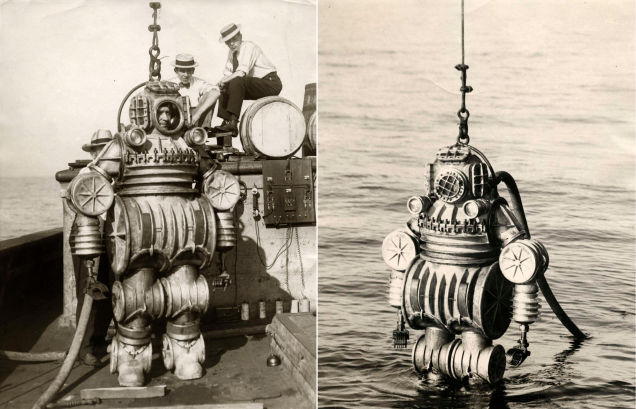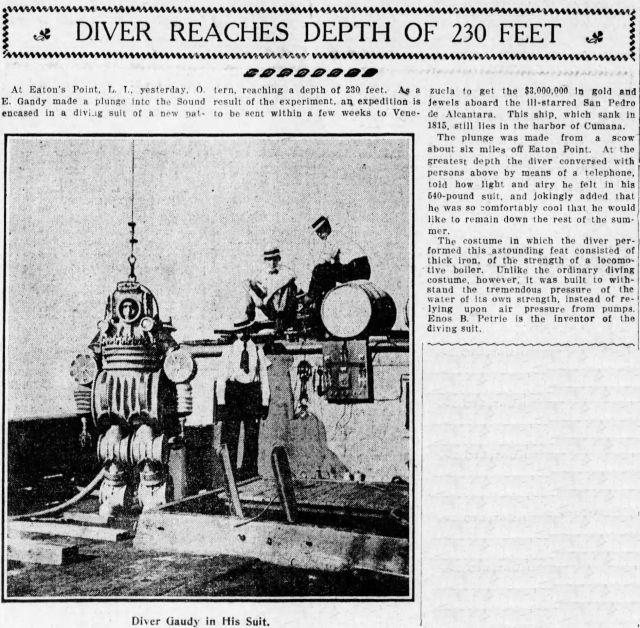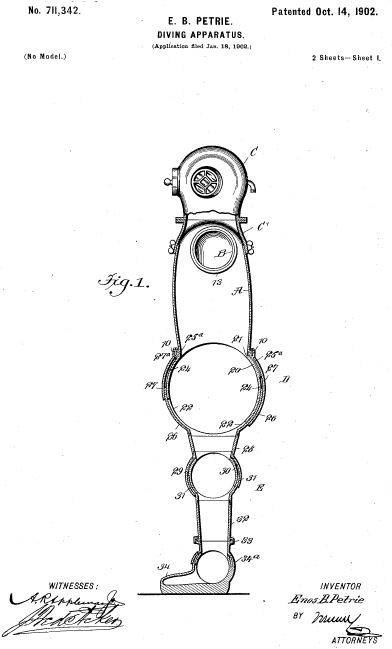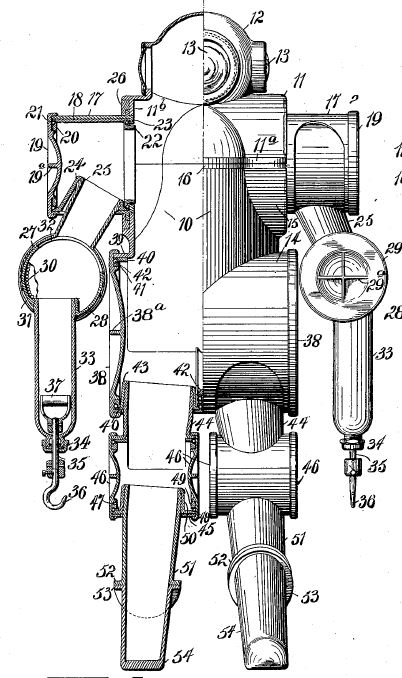1902-7 – "Iron Man" Diving Apparatus by Capt. Enos B. Petrie and Joseph E. Martin. It is diver O. E. Gaudy (Gandy?) inside the suit who set the new diving record at the time.
Source: The Brooklyn Daily Eagle, Aug 23, 1907.
Petrie's diving armor is similar to Macduffee's Armor of 1910.
Publication number US711342 A
Publication type Grant
Publication date Oct 14, 1902
Filing date Jan 18, 1902
Priority date Jan 18, 1902
Inventors Enos B Petrie
Original Assignee Enos B Petrie
My invention relates to an improvement in diving apparatus, particularly such apparatus as is employed for deep-sea diving, and to so construct the apparatus that it will withstand the pressure of deep water and yet may be worn with comparative comfort.
A further purpose of the invention is to so construct the diving apparatus, armor, or suit that a perfectly-articulating water and air tight joint is provided at the connection of the hip, body, and leg sections and the knee, ankle, and elbow sections or wherever movement of the body or limbs is necessary or desirable, the movement attainable being in any necessary direction, thus affording to a diver in a heavy suit the greatest freedom of action.
A further purpose of the invention is to provide a connection between the arm-sections of the armor or suit and the body-section which will permit the arm-sections to be turned as occasion may demand and also to provide a swivel connection between the hand or mitten sections and the arms.
Petrie's initial invention most likely did not work very well. He later enlisted the help of a mechanical engineer Joseph E. Martin, who designed the next version.
Publication number US735809 A
Publication type Grant
Publication date Aug 11, 1903
Filing date Oct 1, 1902
Priority date Oct 1, 1902
Inventors Enos B Petrie, Joseph E Martin
Original Assignee Petrie Deep Sea Diving Company
Our apparatus embodies a device to be used as a diving-suit incasing a human body and conforming thereto in outline approximately and having at the places coinciding with the movable parts or joints of the body articulated junctures of the parts of the apparatus.
Our invention is also designed to present a diving-suit capable of withstanding severe pressure, at the same time allowing enough room for the free action of the body, which, coupled with the aforesaid articulated joints, allows great freedom of action to the diver, and therefore facilitates the working at depths not attained in the diving-suits as now constructed.
Another feature of our device that we desire to emphasize is the construction that embodies great strength and stability with a minimum amount of metal.
There were further improvements to the suit. See patents USUS766465, USUS767659 and USUS984104.
Source: The Brooklyn Daily Eagle, August 23, 1907.
ALL DIVING RECORDS BROKEN YESTERDAY
Man Clad in Metal Armor Goes to Depth of 204 Feet.
WILL REVOLUTIONIZE DIVING.
Suit Is Invention of Brooklyn Man, and Will Make Possible Recovery of Sunken Treasures.
The most wonderful test of deep sea diving ever attempted was made yesterday afternoon in Long Island Sound, about six miles northeast of Eaton's Point. A diver who had never been in suit before easily reached bottom at ,the carefully measured depth of 204 feet and came up as fresh and smiling as though he had never left the deck. Heretofore depths of more than 90 feet have rarely been accomplished and then the diver came up, as one of them said yesterday, "All In"; that is, thoroughly exhausted. In all previous cases flexible rubber suits with metal helmets were used and the diver incased in one had to breathe air more or less compressed, according to the depths reached. In the test made yesterday the whole business and possibilities of diving in deep water have been revolutionized and the widest possibilities of recovering lost merchandise made feasible. This is done by the use of a diving suit composed wholly of metal, an alloy of aluminum, that when donned gives an exaggerated idea of the armored warriors of ancient days. This suit alone weighs 450 pounds, and to this had to be added 90 pounds of lead to meet the great depth reached yesterday. The suit is the invention of Captain Enos B. Petrie of 22 First street, this borough. He is an old tugboat man and for years past has turned his attention to the possibility of recovering cargoes lost at depths utterly unattainable by ordinary diving methods. He has been entirely successful, as yesterday's test proves, and there is little doubt that with his device a depth of 400 feet could be reached with a suitably strong suit. The suit used yesterday is a really remarkable contrivance. The diver is completely enclosed in a meal armor, with joints that work freely at the shoulders, elbows, knees and ankles. These are pretty nearly watertight, being secured with rubber gaskets. One of the troubles of divers is cold in the hands while under water. In the Petrie suit there is nothing of the sort, the hands being incased in metal also, but on the ends of the arms are jaws, which can be operated easily, and with them yesterday there was not the slightest difficulty in picking up matches off the deck. On the back of the armor is a square projection like a knapsack which contains a small pump capable of handling 400 gallons of water an hour and from this lead two small hose to the bottoms of the huge boats that encase the feet of the diver. This pump is operated by compressed air from a compressor on deck. This is furnished by a hose capable of sustaining a pressure of 210 pounds. This hose also carries a smaller hose which furnishes atmospheric air to the diver and telephone and electric light wires. This pump forces out any water that may seep through the joints of the armor; but the diver breathes only atmospheric air and suffers from none of the oppression that affects all men breathing compressed air, whether in the ordinary diver's suit, or in a tunnel, and which causes the painful disease known as "the bends." The armor is reinforced with projecting ribs that enable it to withstand the enormous pressure of the water at the depth reached yesterday, without any counterbalancing pressure from compressed air within the suit. The helmet is screwed on to the body of the suit at the chest, then the arms are screwed in at the shoulders, the hand pieces are added and then the boots and at the last the face plate and the diver is ready for business. This is a brief description of the armor and modus operandi used yesterday. The tugboat Maria Hoffman and Ernest Rudolph's barge, the Mary H. Brainard, were scheduled to leave the foot of Twenty-fifth street at 6:30 o'clock yesterday, but there were delays and it was not until an hour later that they swung around into Gowanus Bay and headed for Long Island Sound. The barge carried the diving equipment and the guests who attended the demonstration, most of whom are interested in the Petrie Salvage Company. Strange to say, investigation of the charts showed that a depth of 200 feet could not be found on the Atlantic coast within forty miles of New York, but these do show a hole of this depth in Long Island Sound, off Eaton's Point, and so this was selected for the test. On board was a strapping young man, O. E. Gaudy, who had volunteered to make the trial of reaching a depth that no man had ever attained before, and returned to tell the tale. Strange to say, he had had no experience whatever in diving and had never before donned a suit. He had served four years, though, in the submarine boat Shark, as engineer, and his experiences in her gave him every confidence in the experiment. All the same, he did not tell his wife yesterday what expedition he was bound on, merely saying he was going on a Asking trip, fearing that she would be worrying about what might happen. He is but 17 years old and is employed in the equipment department at the Navy Yard. He went down smiling and came up as chipper as a lark and wanted to go down again, but every one protested, saying that the test had been a complete success. On the way to Eaton's Point a long stop had to be made off Larchmont for another contingent of guests, who had come on by rail. Among these were three South Americans who are not on good terms with their home government. They were deeply interested in the trial. Two of them are said to have in view the salvage of a vessel named the San Pedro de Alcantara, lost in Cumana Bay in 1815. and reported to have $300,000 in treasure on board, and also in exploiting the pearl fisheries off Trinidad. The third said he represented a pearl fishing concern in Australia. It was noon before the expedition left Larchmont and it was three hours later before the 200 foot hole was located. Emanuel Johnson, another diver of long experience, had joined at Larchmont. He had made all the preliminary tests under hydraulic preserve and eagerly sought to go down, but Captain Petrie decided the he was too small, as the suit had been adjusted to the size of Gaudy, who is over six feet in height. Johnson was disappointed, but had to get into it's suit anyway and his wish was granted.
The first soundings showed 134 feet of water, so the boats were moved until the captain of the boat announced that, over 200 feet had ben reached. The lead line was passed to the barge and in the presence of all a cast taken, which showed 204 feet. Captain Petrie decided that this would do. Gaudy, attired in heavy blue underwear was clad in his coat of armor, the boots and arms were screwed on, the telephone adjusted and the face plate screwed into position. The metal suit bad been lying in the sun all day and was intolerably hot. The engine was started up and the huge figure slowly raised and then dropped overboard. Every man on board felt a thrill of apprehension as the diver disappeared, with the exception of Captain Petrie and Diver Johnson, who were as confident as possible that there was no possibility of an accident. The telephone was in constant use and Gaudy said he was quite comfortable at 60, then at 100 feet, later at 150 and next he announced that he was on the bottom and "feeling as fine as silk." The amount of hose run out showed some more depth than the headline indicated, but this was no doubt due to tho drift of the tide. Unfortunately the dynamo gave out and he could not use the two small searchlights on the front of the armor.
The newspaper men and others talked with Gaudy, through the telephone, and he was evidently feeling very well. He went into the water at 4:17 o'clock and reached 100 feet in less than 3 minutes and touched bottom at 4:23 o'clock. After walking about for a few minutes he was hauled up and landed on the deck of the barge at 4:30 o'clock. As soon as the face plate was removed he said he never felt better and wanted to make another descent; Captain Petrie wished it, too, but the general sentiment was against it, as it would accomplish no more than had already been achieved, and so the second descent was reluctantly abandoned.
Mr. Gaudy's announcement by telephone that he had reached bottom was hailed with enthusiastic cheers and men ran about shaking each other's hands. Gaudy said he could hear these cheers distinctly while on the bottom. He said he was in absolute darkness save that he saw occasional tiny flashes, which he believes came from some phosphorescent little fishes.
The bottom was a soft mud and he sank some inches in it. He felt no inconvenience whatever from the weight of the suit, the joints all moved freely and he had full control of his artificial hands, which, by the way, look a good deal like the claws of a bear. He experienced no more difficulty in breathing than in the open air and found the air in a submarine boat far more oppressive, or even that at the the top of a twenty story building. The water had cooled the hot metal and he was perfectly comfortable at all times after entering the water. He said he was sure that a man could remain for hours under water at almost any depth with a suit built to withstand the pressure of the water, the air being no inconvenience whatever. Both Captain Petrie and Mr. Gaudy were most warmly congratulated on the success of the trial. The construction of two suits had occupied three years at Harrison, N. J., but their immense value was amply demonstrated yesterday. The absolute safety to the diver and the absence of any symptoms of exhaustion marks the test a wonderful one. Another feature of it was the rapidity with which Gaudy was hauled to the surface. Under the old methods this had to be done very slowly, and when the diver reached the surface from any considerable depth he was always much exhausted.
Captain Petrie said that there is untold wealth lying at the bottom of the Great Lakes and he intends to try for some of the lost cargoes. This is only part of the general scheme of the Petrie Salvage Company. Before the work commenced he asked the newspaper men to merely state the facts as they saw them. Every part of the operation was open and above board. There could be no doubt about the depth attained, as both the lead line and the hose proved this and Gaudy brought up a quantity of greasy blue mud on his huge boots to demonstrate that he had sunk deep into the bottom. The mud was eagerly seized upon and carried away as a souvenir of the greatest feat of diving on record.
This day had been a glorious one, just cool enough to make the trip pleasant, and there was abundance of refreshments on board Rudolph's barge. The sun was setting before the anchor was inboard and a start made for home. A stop was made uptown to allow the Manhattan men to get off, and it was pretty close to midnight before the Brooklyn men were landed at the foot of Twenty-fifth street. Most of those on board are interested in the company, and a strange thing about it is that it has been entirely financed by men of small means.
Among those on the Mary H. Brainard were Captain Petrie, O. E. Gaudy, Emanuel Johnson, Charles Hanna, Ernest Rudolph, W. S. Wright, William B. Hotter, William B. Hotter, Jr.; William Axtell. Richard Spink. Harry Rapp, Eugene Reardon, Thomas Farrell, Michael Hanraban, Jacob H. Holen, John Keenan, B. Givannonino, Chester E. MacDuffee. J. L. Gordon and the South Americans referred to.
[Note the name 'Chester E. MacDuffee', who was to later patent and build his own Diving Armor, visually similar to Petries' design.]
end
THE DULUTH HERALD, VOLUME XXX— NO. 89, MONDAY EVENING, JULY 22, 1912.
Trying to Recover Valuable Cargo.
Alpena. Mich., July 22.—While a diver was rambling around the deck of the sunken steamer Pewabic Thursday, the former steamer Meteor, now the barge Nelson Bloom, the Pewabic’s sister ship and the boat that sank the Pewabic, passed up the lake, saluting the expedition that is trying to recover the copper from the sunken wreck.
Thirty lives were post when the Pewabic sank in Thunder bay, Aug, 9, 1865. nearly forty-seven years ago, after collision with the Meteor. The Pewabic carried about 450 tons of copper. Numerous attempts have been made to recover the valuable metal, but as the old wreck lies in 160 feet of water, the work of previous expeditions was in vain. Yesterday, however, a diver descended to the old wreck and actually handled some of the copper, but was compelled to return to the surface when warned by telephone that the lake was becoming rough.
The present expedition is in command of Capt. Petrie, who has twelve men and the wrecking steamer Douglas. While Capt. Petrie refuses to talk, saying the work of the expedition is none of the public’s business, and his crew are forbidden to talk, it is known that those in charge of the expedition believe the 450 or more tons of copper will be recovered and can be brought to the surface on days when the lake is quiet.
Two improved diving suits, which the crew call “iron men,” are used in the diving operations. The divers are inside these “iron men” and with limitations can work on the bottom of the lake below the surface 160 feet almost as well as on dry land. Each “iron man” is connected with the vessel above by telephone and the divers below the surface can talk to those above as well as receive messages. The wreck lies four miles off Thunder Bay island and about eighteen miles from the mouth of Thunder Bay river.
See other early Underwater Robots here.






